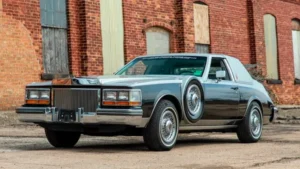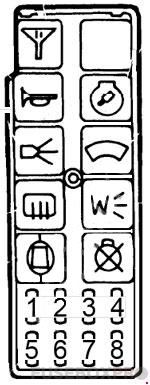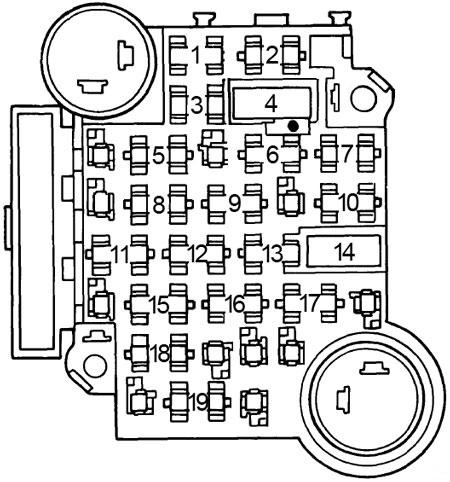Cadillac Seville (1979-1981) fuse box and relay Diagrams

The Cadillac Seville from 1979 to 1981 marked a significant era for luxury sedans, known for its innovative features and refined design. Its electrical system, encompassing the fuse box and relay components, played a crucial role in its operational efficiency and reliability.
During this period, the fuse box in the Cadillac Seville housed fuses that protected various electrical circuits across the vehicle. These circuits powered essential components such as the engine control module, lighting systems, climate control, and entertainment features. Fuses were designed to prevent electrical overload by breaking the circuit in case of an anomaly.
Relays in the Cadillac Seville acted as electrically operated switches responsible for managing high-current circuits. They facilitated the precise activation and deactivation of functions like the starter motor, fuel pump, air conditioning compressor, and power windows or seats. This efficient distribution of power ensured optimal performance of the vehicle’s electrical systems.
Regular inspection and maintenance of the fuse box and relays were crucial to ensure the Cadillac Seville maintained its operational excellence. This included checking fuses for signs of wear or damage, ensuring relay connections were secure, and promptly addressing any electrical issues. Proper care of these components contributed to preserving the vehicle’s electrical integrity, enhancing safety and driving satisfaction in the Cadillac Seville 1979-1981.
MUST READ: DYI – How to Check Car Fuses?
(1979-1981) Cadillac Seville fuse box and relay with Diagram
WARNING
- Never replace a fuse with one that has a higher amperage rating.
- A fuse with a too-high amperage could damage the electrical part and cause a fire.
- On no account should fuses be repaired (e.g. patched up with tin foil or wire) as this may cause serious damage elsewhere in the electrical circuit or cause a fire.
- If a fuse blows repeatedly, do not keep replacing it. Instead, have the cause for the repeated short circuit or overload tracked and fixed.
- Terminal and harness assignments for individual connectors will vary depending on vehicle equipment level, model, and market.
Cadillac Seville 1979-1981 fuse assignment
- Cigar lighter / power outlet fuses in the Cadillac Seville is the fuse №.12.
Year of production: 1979, 1980, 1981

| No. | A | Circuit Protected |
| 1 | 3A | Fuel injector |
| 2 | 3A | Fuel injector |
| 3 | 3A | Fuel pump cranking circuit |
| 4 | 20A | ECS battery |
| 5 | 10A | MDA ignition |
| 6 | 10A | Fuel pump |
| 7 | 15A | ECS ignition |
| 8 | – | – |

| No. | A | Circuit Protected |
| 1 | 10A | Cornering, side marker, opera, right door ash tray, instrument panel ash tray lights |
| 2 | 3A | Cruise control, DFI brake switch |
| 3 | 5A | Rheostat controlled instrument panel lig hts |
| 4 | – | – |
| 5 | 10A | Back-up lights, diesel fast idle, diesel controller |
| 6 | 20A | Air conditioning compressor feed, ECC programmer and power module, rear defogger relay coil, generator indicator |
| 7 | 10A | Antenna motor feed |
| 8 | 20A | Turn signal lights |
| 9 | 25A | Opera, license, tail and rear side marker lights |
| 10 | 20A | Stop light switch, hazard warning flasher, ECC control head |
| 11 | 20A | Fuel gauge, oil pressure and coolant temperature indicator, low brake fluid indicator, seat belt warning chime and indicator, electronic level control compressor, downshift switch |
| 12 | 20A | Key warning buzzer, coolant temperature indicator, instrument panel courtesy and compartment lights, cigar lighter, engine telltale light, glove box light |
| 13 | 25A | Automatic Temperature Control blower |
| 14 | – | – |
| 15 | 10A | Radio, antenna relay coil |
| 16 | 20A | Electronic fuel injection (’79) |
| 17 | 20A | Body courtesy lights, cigar lighters, level control height sensor, ash tray lights |
| 18 | 25A | Windshield wipers and low washer fluid indicator |
| 19 | 25A | Rear window defogger |
Circuit Breaker:
- Headlights (Twilight Sentinel) — Integral with headlight switch.
- Windshield Wiper — Integral with windshield wiper switch.
- Rear Defogger — Circuit breaker located on lower steering column cover reinforcement.
- Sunroof — 25 amp. On body bracket at upper right corner of fuse block
Fusible Link:
- Accessories & Body Feed — 16 gauge fusible link located in black/red stripe wire at starter
- Ignition — 16 gauge fusible link located in red wire at starter solenoid
- Headlights — 18 gauge fusible link located in yellow wire at starter
- Charging — 16 gauge fusible link located in red/white stripe wire at junction block
- Fuel Injection Electronic Control Unit – 18 gauge fusible link located in dark green wire on “BAT” terminal of alternator (’79).
In-Line Fuse:
- Vanity Mirror — 2 amp. fuse located behind mirror
- EFI Fuel Pump — 10 amp. fuse located left of fuel injection electronic control unit brown wire (’79)
- Theft Deterrent — One 20 amp. fuse for lights, and one 25 amp. fuse for horn is located above radio in instrument panel.
- Trunk Lid Pull Down — One 20 amp. fuse is located behind right hand fabric rear end panel inside trunk.
Conclusion
For owners and enthusiasts of classic Cadillac Seville 1979-1981, understanding the fuse box and relay systems is essential for vehicle maintenance. Regular inspection and maintenance of these components helped ensure the vehicle’s longevity and reliability, preserving its status as a symbol of Cadillac’s craftsmanship and innovation in the automotive industry during that era.